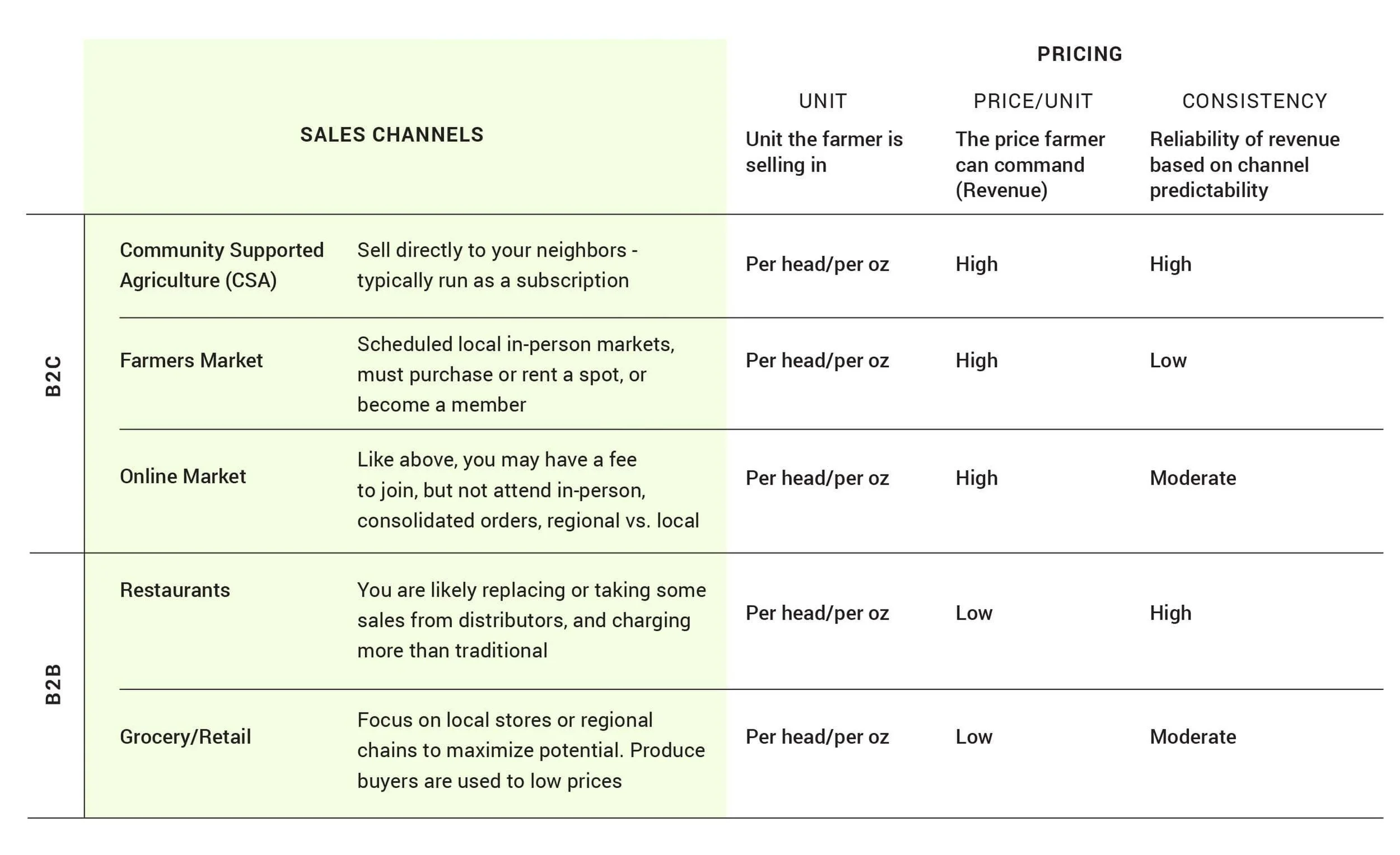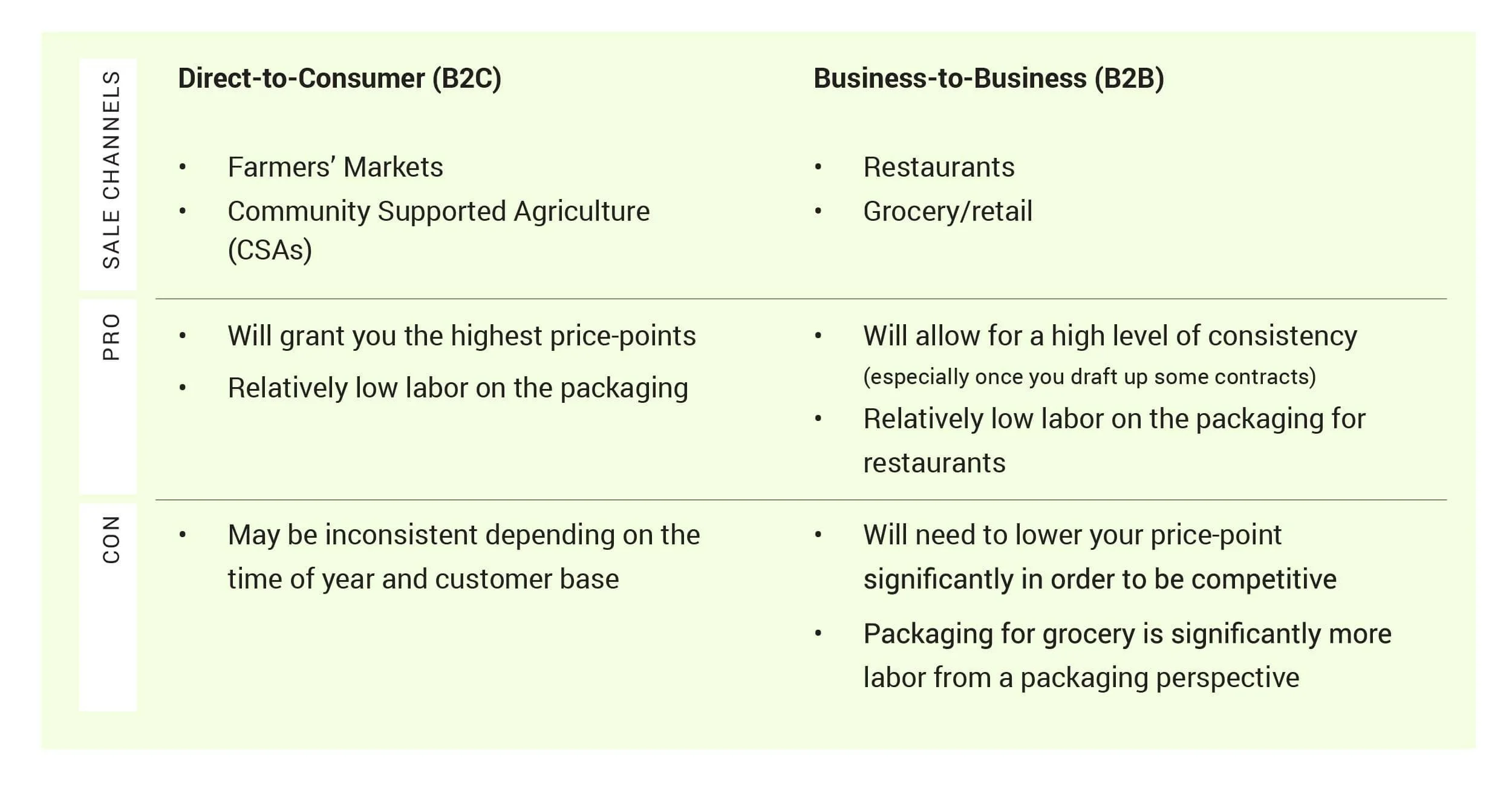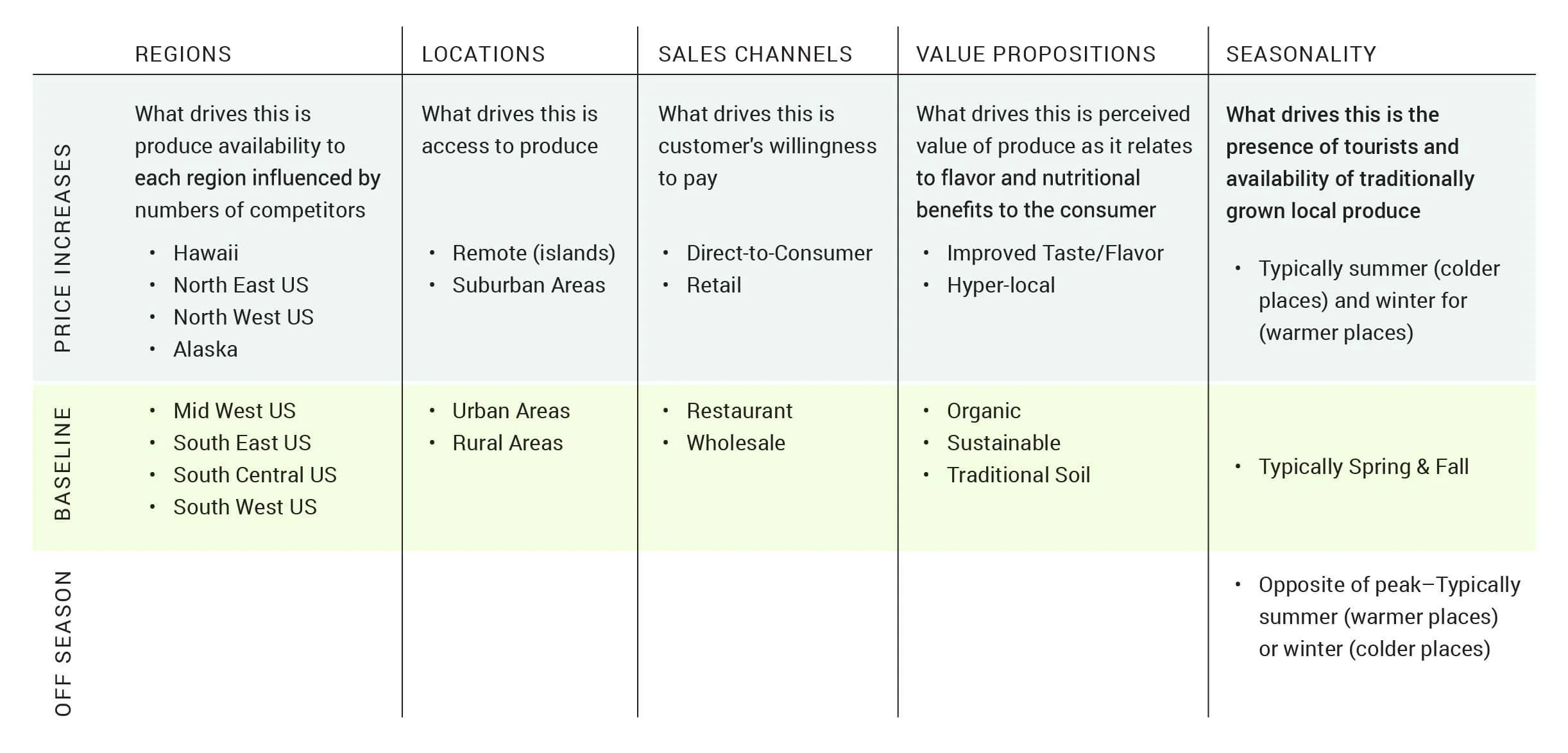How To Price Your Produce
September 6, 2024
Ensuring your crops are priced correctly is crucial to your overall success.
Many new Freight Farmers don’t come from an agricultural background, so learning how to set crop prices is unfamiliar territory.
Establishing an optimal price point can be challenging. Pricing too high might deter customers, but pricing too low means missing out on potential revenue. How much do your customers value hyper-local produce?
To determine the best pricing structure, you must research your market. The basic approach is to find a comparable item in your market (your baseline) and then increase or decrease that price based on your region, location, sales channel, value proposition, and seasonality.
In this guide, we'll help you identify the ideal sales channel, outline the process to establish your pricing, and offer recommendations for moving forward.
Your baseline price will vary depending on your target market, so let’s start by determining which sales channel makes the most sense for your operations.
Pricing considerations by sales channel – B2B
Restaurant & Bars
When selling to restaurants, you can guarantee chefs consistent quality, quantity, and pricing and even offer to customize your crops to fit their needs, including less common varieties that aren’t typically available commercially.
Considerations:
Consistent deliveries allow you to build relationships with chefs and restaurateurs, who can, in turn, further connect you within the local hospitality landscape.
You can ask to have your farm’s name featured next to relevant menu items, which lends itself to a marketing opportunity.
There are higher standards of quality and consistency – chefs may reject an order if the quality is below standard.
You’ll be competing with other vendors that may be able to offer lower price points.
Grocery & Retail
Grocery stores offer a wide range of products at various price points and qualities.
Many consumers choose larger grocery stores for the convenience of finding everything they need in one place and often shop based on price to find the most affordable items. Within the grocery store category, there is significant variation. A grocery store like Whole Foods caters to a different demographic and price range compared to stores like Walmart.
Comparing the prices of your products to major grocery brands is a recipe for disaster – you aren’t competing with Walmart. The customer base that shops at these stores for groceries typically differs significantly from those willing to pay for high-quality, locally sourced, fresh produce. Instead, farmers should focus on comparing their prices to local competitors or, if none exist, to higher-end grocery stores such as Whole Foods or boutique markets.
Considerations:
Grocery and retail stores can be viewed as marketing channels that drive brand awareness for other sales channels like CSAs.
The farmer can prioritize sales of herbs rather than lettuces and greens to compensate for the retailer’s cut, which has reduced margins.
You’ll be competing with low-cost mainstream produce.
Food safety certifications are likely required.
You’ll need to consider the retail shelf life & storage needs of produce.
Establishing your B2B baseline price
If you plan to sell through B2B sales channels, you’ll need to determine your B2B baseline. Start by researching average retail prices in the nearest market to you. If no markets exist locally, expand your search to the closest larger town.
Grocery stores typically apply a 40% margin above their wholesale price to cover around 30% of their operating costs. As a general guideline, multiply the average retail price per lb or unit by 60% to estimate the wholesale price. Be cautious with wholesale unless you’re providing a specialty item they're willing to pay a premium on.
Pricing considerations by sales channel – B2C
Community Supported Agriculture (CSA)
A traditional CSA is a shareholder model in which farmers plot out at the beginning of the “season” how many shares they have. They then sell those shares up front to people who are locked into the season so that the money is coming in as they grow.
Farmers and customers expect shares to vary from week to week; some weeks, there may be no produce, and some weeks, there may be an overabundance. In this way, the share price that the farmer sets reflects the average value of each box over the course of the season, buffering against any potential crop losses.
As a Freight Farmer, your “season” can be as long or as short as you’d like it to be, but we recommend going no shorter than 8 weeks (one full crop from seed to harvest).
Considerations:
As a container farmer, you’ll have an edge over traditional soil-based farming CSAs, where there’s an expectation of inconsistent produce due to natural forces.
The expectation of week-to-week variation in produce bundles also allows for creativity on the part of the farmer.
CSAs are a great way to introduce customers to new products and get them hooked.
Certain specialty crops may have low consumer awareness, requiring additional educational resources on how to use them (e.g., recipe cards with weekly share boxes).
Farmers Markets
If you’re a school or nonprofit looking to break even on your crop, you may want to prioritize this channel and offer pickup onsite (storage and refrigeration required).
Considerations:
This channel allows in-person relationship building with customers who can sign up for your CSA.
Opportunity to cultivate brand awareness among like-minded individuals and network with other local growers and businesses.
Larger markets sometimes have wait lists for vendor entry.
Online Markets
When selling your produce online, customers can buy whatever they want as one-time purchases.
Quick tips:
This channel makes it easy to compare pricing and offerings with other online growers in your area.
Larger customer reach than in-person markets.
Less relationship-building and in-person interaction than face-to-face options.
Brand awareness and competitive product offering are crucial because customers need to seek out your page directly rather than stumbling upon you by happenstance.
Establishing your B2C baseline price
Due to lower demand in this market, start by researching your competitors.
Success often hinges on offering something unique that others cannot, minimizing the threat of competitors undercutting you. Investigate the market you plan to enter, whether it’s through physical stores or online platforms like Local Line, to assess product opportunities and pricing trends. Local Line is an all-in-one sales platform helping new farmers launch successful businesses — see how our partnership could impact you.
For example, let’s say five local farmers on Local Line are selling hydroponic butterhead lettuce at $3.00 per head (the average retail price is $1.00 per ounce). Instead of lowering your price to $2.75 per head, consider offering a unique spring mix at a slightly higher price point, such as $16 per pound (on average, $3 per head equals $12 per pound), and gauge demand from there. This approach could potentially increase your revenue by 25% if you dedicate your entire farm to this crop.
Choosing your sales channel
The optimal approach is to focus on direct-to-consumer pricing to maximize revenue and minimize operating costs.
CSA models typically involve around 100 shares per farm. You can deliver the orders to two central locations, ideally to coolers at a café. This setup increases foot traffic for the café and provides a convenient pickup point for customers.
That said, in some locations, the consumer willing to spend extra on high-quality produce might be seasonal, so while you might sell out all summer, you may struggle to find demand in winter. In this case, explore whether your market can support a winter CSA to maintain direct-to-consumer sales. If not, consider partnering with a restaurant that might commit to purchasing specific items they cannot source elsewhere (e.g., wasabi arugula) and is willing to pay premium prices above wholesale. Maximizing prices for your produce will significantly boost profits, much more than cutting costs (potentially around 4x more).
If you also want to sell wholesale, we recommend keeping some of your sales direct-to-consumer through farmers markets, online platforms, or CSAs. However, many Freight Farmers, such as King Tide Farms or Beats Per Minute, sell exclusively to restaurants or grocery stores and have achieved strong revenue. This approach is viable if it aligns with your goals and your market allows you to focus exclusively on B2B sales.
For a more detailed guide on selecting your sales channel, calculating your breakeven point, and strategies to drive profitability, download our comprehensive Breakeven & Profitability Workbook.
Pricing considerations by region and season
In most parts of the US and northernmost locations (like Montana or Alaska), sales will peak during the summer tourism season. This primarily affects wholesale and restaurant sales, who will be willing to pay a premium and use your produce in menu offerings that cater to tourists.
Conversely, direct-to-consumer sales (like CSAs and online stores) will likely peak in the colder winter months as customers turn to your uniquely year-round offerings to offset the lack of local produce in supermarkets. Warmer states known for their snowbirds (like Florida & Hawaii) will have the opposite effect, with tourism peaking in the winter months.
Adjusting your price from the baseline
Once you have a baseline price for your product, adjust the price point if any of the 'price increase' criteria apply to you based on your region, location, sales channel, value proposition, and seasonality (see image below).
When adjusting your price, you can assume a 5 to 20% increase or decrease for each factor.
Some pricing tips to keep in mind
Utilize pricing psychology
One farmer in Salt Lake City set his price for lettuce at $6 for 6 ounces. However, when he had excess product, he reduced the price to $5 and completely sold out. It turns out that customers found it easier to pay with a single $5 bill than to use multiple bills, making them more likely to buy. Now, he charges $5 and removes a head of lettuce from the sales unit, resulting in a higher unit price per ounce. Sometimes, there’s no clear formula for pricing—calculations on paper are important, but real-life factors also play a big role.
Work with (not against) competitors
St. Charles Community College contacts every farmer in their area to inquire about their crops and intentionally avoids selling the same produce. Even if you have other Freight Farms in your area, you don’t need to fear competition. Farmers can collaborate or form alliances, leveraging their presence to distinguish yours.
Similarly, contact local wholesalers and ask for sample pricing to get a starting point. This will give you a foundation to build from.
Use scarcity to your advantage
Scarcity creates demand. If you sell out of something – tell your customers! Let them know through social media posts or signage at your booth that they’ll need to follow you to be notified of when the product is back in stock. Some farmers deliberately create demand by limiting the quantity of sales and increasing prices when certain crops are unavailable. For example, they might grow specialty crops less frequently, such as once a month or quarter, to influence consumer purchasing behavior through scarcity.
When you do have these specialty crops available, offer samples to customers to get them hooked and eager to purchase in the future. This strategy builds anticipation and loyalty among customers, driving demand when the product becomes available again.
Upsell existing customers
While getting new customers is great, upselling to existing customers is another effective strategy for scaling your business. Increasing both your customer base and the amount each customer spends can significantly boost revenue. To successfully upsell your customers, focus on selling premium products and continually improving your offerings.
For example, starting with a basic lettuce mix and gradually introducing a deluxe mix with herbs, edible flowers, or rare greens can attract customers who appreciate high-quality produce. Building a loyal customer base that values your products increases the likelihood of repeat purchases and raises revenue per customer over time. This approach not only strengthens customer relationships but also supports sustainable business growth.
Conclusion
It’s important to understand that you will not set the perfect price from the beginning, and that’s precisely why it’s important to track your data. Doing so allows you to monitor the impact of price adjustments on unit sales and revenue while continuing to adjust as needed.
Freight Farms has historically observed many farmers lowballing their own prices and underselling themselves. It's essential to recognize the unique value of your specialty products. Remember, setting higher initial prices and adjusting downwards if necessary is generally more feasible than increasing prices later with an established customer base.
In any market, some people may find your prices unaffordable, and that's okay. The key is identifying if there's a sufficient customer base willing to pay your prices consistently, ensuring you can sell out week after week. Starting with higher prices and gradually testing lower prices can help determine the optimal sales volume for your market.
Pricing strategies are highly specific to each market and individual farmer. Our team is always available for personalized guidance, so please don't hesitate to reach out if you need assistance—we're here to support you!
To continue refining your pricing strategy, we recommend utilizing our Hydroponic Farming Profit Calculator. This calculator allows you to input your ideal crop types, sale prices, electricity costs, and labor wages to determine the most effective approach for maximizing profitability.
Utilize the resources below to further assist you in establishing your pricing structure:




